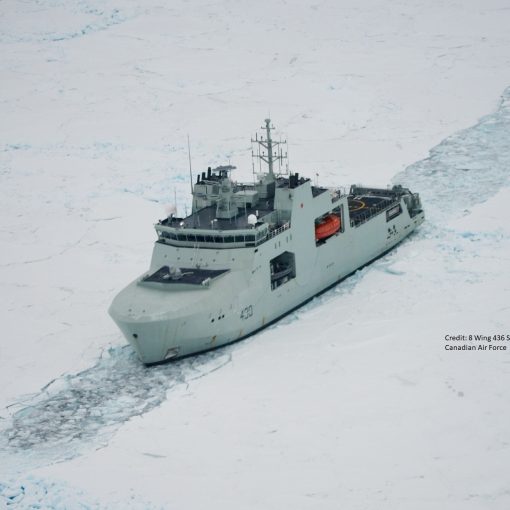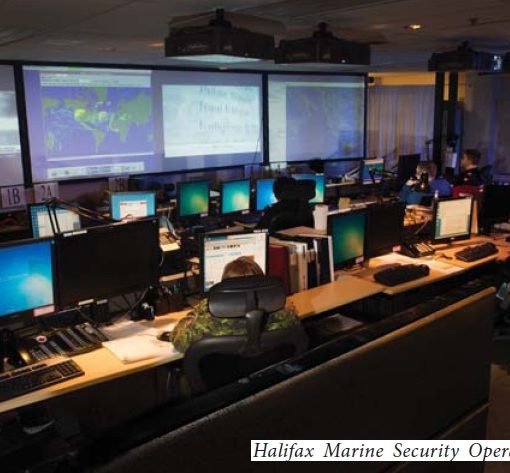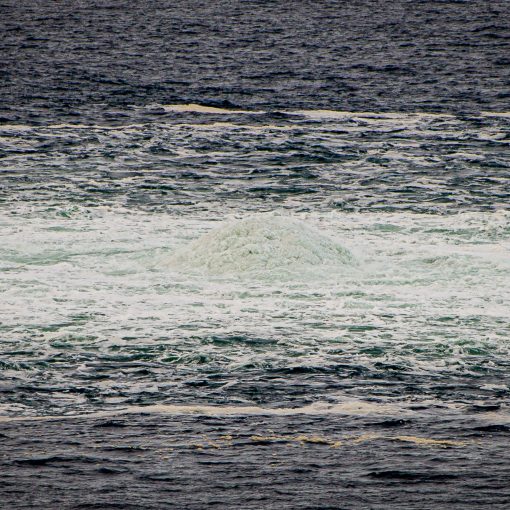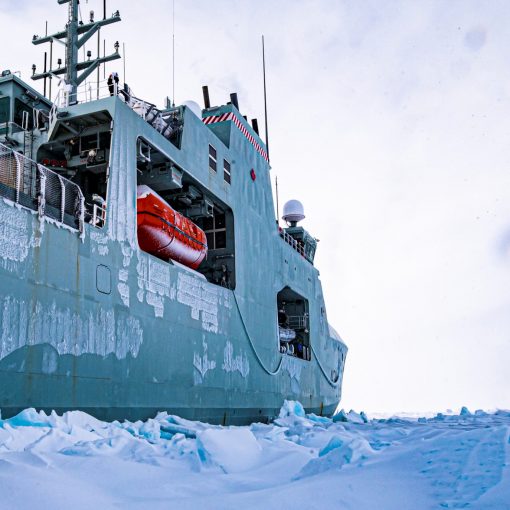David Dunlop, 20 February 2020.
In light of the impact that global warming is having on Canada’s northern borders and the increased Arctic activity by countries other than Canada, it is becoming more urgent than ever that Canada take measures to display and maintain surveillance and sovereignty in the high Arctic. This commentary outlines the capabilities that unmanned aerial vehicles (UAVs) can provide as well as discusses how their capabilities can assist in achieving Canada’s national defence surveillance requirements. Specifically, one UAV, the MQ-4C Triton High Altitude Long Endurance (HALE) drone will be reviewed by applying its capabilities to aerospace power, its characteristics and applications for Canada.
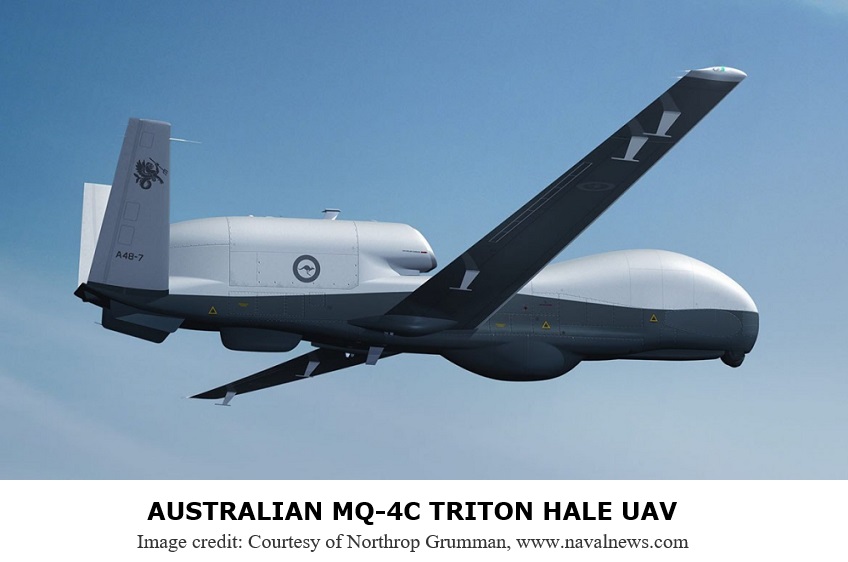
The Mandate Letter of the Minister of National Defence (MNDs) from the Prime Minister (Minister of National Defence Mandate Letter-Ottawa, 2015, http://pm.gc.ca/eng/minister-national-defence-mandate-letter) directed him to renew Canada’s focus on surveillance and control of Canadian territory and approaches, particularly our Arctic regions. Canada must augment its maritime aviation security to adequately monitor its vast borders, national waters and airspace, particularly in the Arctic. One could, however, question whether the aerospace powers that the RCAF currently possess are sufficient in numbers and capability.
In order to fulfill its national defence requirements, the United States is currently increasing its use of military-specific UAVs. One UAV in particular is Northrop Grumman’s RQ-4 Block 40 Global Hawk HALE, which operates active electronically scanned array radars that deliver higher resolution than that available in baseline systems, as well as integrated sensor suites that synthesize inputs from the system’s radar, cameras and other sensors. As a result, the RQ-4 Global Hawk can conduct air-to-air surveillance as well as track individuals, vessels and ground vehicles. While the United States has utilized the Global Hawk for many years, recently the US Navy has changed its focus towards another Northrop Grumman Unmanned Aerial System (UAS), the MQ-4C Triton HALE UAV. This is a variant of the RQ-4 Global Hawk that is more in line with maritime requirements, hence, it is called the MQ-4C Triton Broad Area Maritime Surveillance (BAMS).
The aerospace power characteristics that are inherent within this drone have made it a sought-after capability for states world-wide. The MQ-4C Triton HALE UAV is suitable for conducting continuous sustained operations over an area of interest at long ranges. It relays maritime intelligence, surveillance and reconnaissance (ISR) information directly to maritime commanders.
Characteristics of the MQ-4C Triton include:
Ref. https://www.naval-technology.com/projects/mq-4c-triton-bams-uas-us/
- A maximum altitude of 60,000 ft;
- A strengthened forward fuselage to the protect various sensors;
- Can fly up to 28 hours in a single sortie. If not refueled (in-flight), has a range of 9,950 nautical miles and fly for 30 hours maximum;
- Max speed - 357mph;
- Internal payload of 1,452kg and External payload of 1,089kg
Sensors
The naval-technology project information outlines the following sensors for the MQ-4C Triton:
- 360-degree Field Of Radar (FOR) sensors;
- Multifunction Active Sensor (MFAS);
- Electronically steered array radar;
- Electro-Optical Infrared Sensor (EO/IR);
- Automatic Identification System receiver (AIS);
- Electronic Support Measures (ESM);
- Satellite Communications relay equipment;
- Multi-Function Information Display System (MIDS) / Link-16;
- Multi-spectral Targeting System (MTS-B) (high resolution imagery and full motion video);
- Tracks and detects emitters of interest (AN/ZLQ-1 ESM).
Mission capabilities
- A maritime surveillance and reconnaissance coverage radius of 2,000 nautical miles;
- Sensitivity to Environment Conditions - radomes provide protection from lightening, hail and bird-strikes along with a wing and engine de-icing system;
- Support - according to the project information provided by Naval Technology, the MQ-4C Triton is operated by four-man crews (air vehicle operator, mission commander and two sensor operators).
Ground [control] station includes:
- Launch and Recovery Element - responsible for ground support equipment and landing/take-off operations; and
- Mission Control Element - responsible for mission planning, coordinating launch and recovery, image analysis and monitoring of communications.
As the focus of world power shifts from west to east, Australia is playing a greater role and is stepping up, including its willingness to bolster its military across the board. Australia is clearly on its way to surpassing Canada as an influential middle power. It is beyond cliché in Canadian defence circles, to look to Australia while lamenting the failures of Canadian procurement policy. Australians, as evidenced by equipment quality and age, quite simply, do it better – and have done so over and over again.
The capabilities of the MQ-4C Triton HALE UAV have caught the keen interest of Australia which signed a deal with Northrup Grumman (NG) on 28 February 2019 for six MQ-4C Triton UAS at a cost of $5.1B USD including moveable ground stations and training. This purchase will be phased in over the next several years and all should be operational by the mid-2020s. Australia has already contracted Northrop Grumman to deliver the first of these platforms, as well as related operating bases and training, and has approved NG to proceed with the second UAS on 27 March 2019. According to Prime Minister Tony Abbott, “these aircraft will patrol Australia’s vast ocean approaches, and work closely with other existing and future Australian Defence Force [ADF] assets to secure our ocean resources, including energy resources off northern Australia, and help to protect our borders”.
Germany cancelled its EURO Global Hawk HALE UAV program in 2013, but the German Defence Ministry is evaluating a recently submitted formal bid from Transport Canada for their prototype Global Hawk HALE UAV aircraft. This aircraft is now incapable of flight after it was stripped of key equipment and demilitarized by the United States in 2017. This drone has been parked at a German air base for the past few years. Canadian media have reported that Transport Canada could use this drone, built by Northrop Grumman, to monitor oil spills, ice levels and marine habitats in remote Arctic regions.
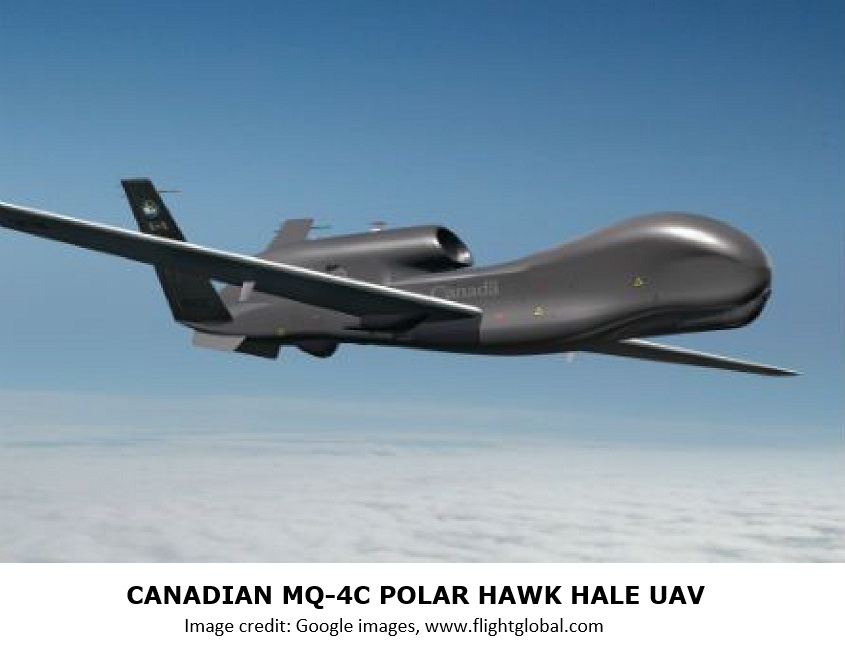
For the Canadian Forces, the capabilities integral to the MQ-4C Triton HALE UAV BAMS, would provide aerospace power that is suitable for support, observation (through MIDS/LINK 16 Data SATCOM) and add a persistent presence in the Arctic. It would provide for the tracking of civilian aircraft and vessels and assist in maritime patrols (including the kind now conducted by the civilian National Aerial Surveillance Program operated by Transport Canada) along with search and rescue. Canada missed a golden opportunity to acquire a fleet of what NG called the MQ-4C Polar Hawk HALE UAV variant which has a wing de-icing and engine anti-icing capability. In 2012, NG made an offer to Canada for the Polar Hawk UAV at a then, reasonable price of $215M USD per unit including ground stations and training. When there was no credible movement by Canada, Northrup Grumman quickly rescinded the offer.
One of the priorities that our Prime Minister has listed is the defence of Canada’s national interests. The challenges inherent with this are related to Canada’s vast borders, maritime waters and airspace. The United States has been very focused on utilizing the technological advances associated with UAVs. In particular, the United States is now looking towards the UAS capability of the MQ-4C Triton HALE UAV BAMS to assist in its broad maritime surveillance requirements. This UAS has the necessary aerospace power characteristics that would enable it to fulfill some key Canadian aerospace surveillance requirements.
Conclusion
Canada is effectively ceding its century-old role as a middle power and, before long, the Australian kangaroo will be a far more respected and feared symbol in the world’s skies than the maple leaf. When one considers the anticipated increase of air and maritime traffic in the Arctic, now is the time for Canada to invest in this Arctic defence surveillance capability. Notwithstanding Transport Canada’s efforts to acquire the German EURO Hawk drone, having a fleet of at least five or six MQ-4C Triton HALE UAV BAMS, as Australia already has invested in, at a cost of between $4 to 5B CAD over the next several years, would help to not only meet the demands imposed by a changing northern environment but would achieve interoperability with our allies and provide aerospace functions that will benefit all Canadians.


